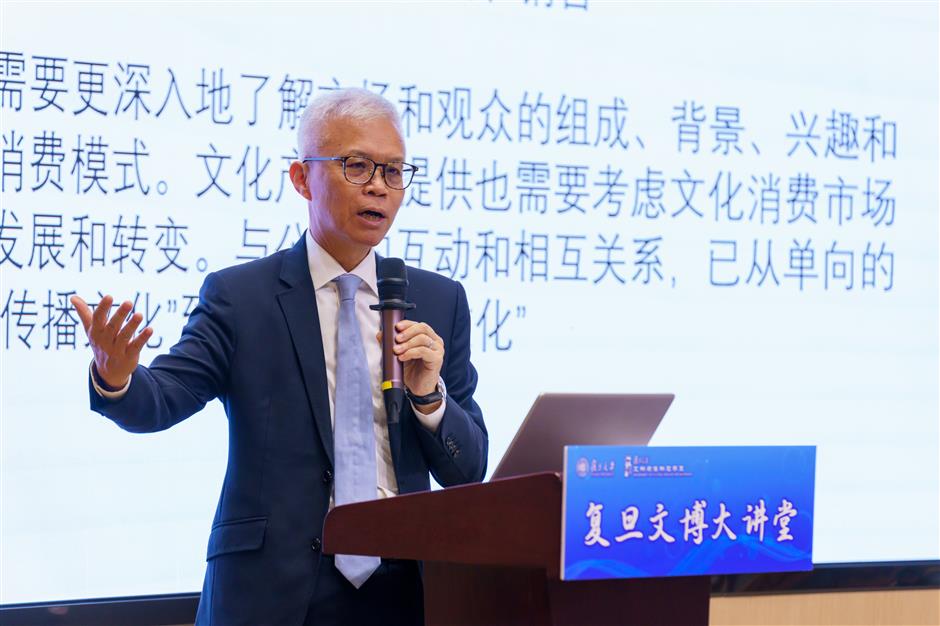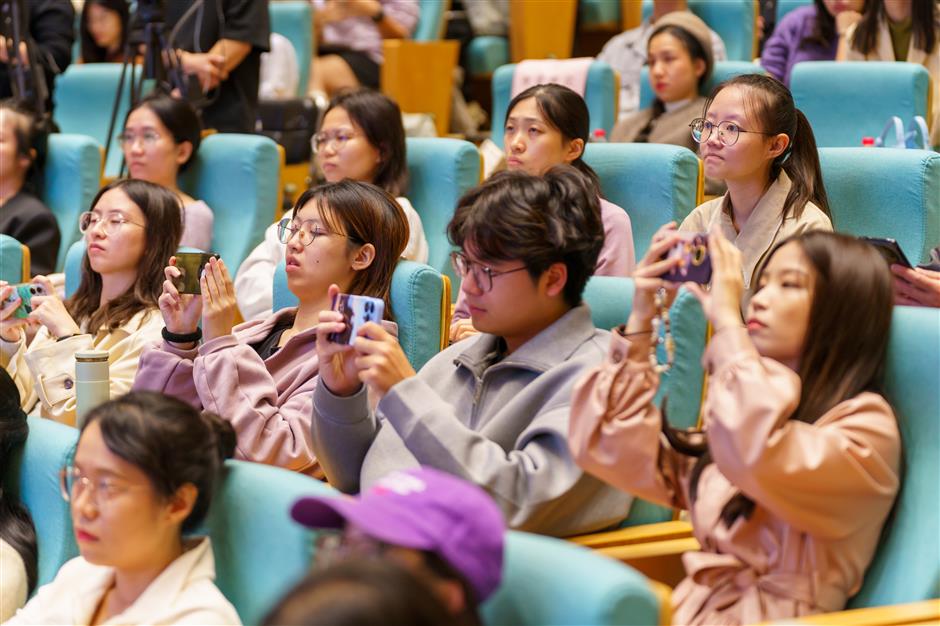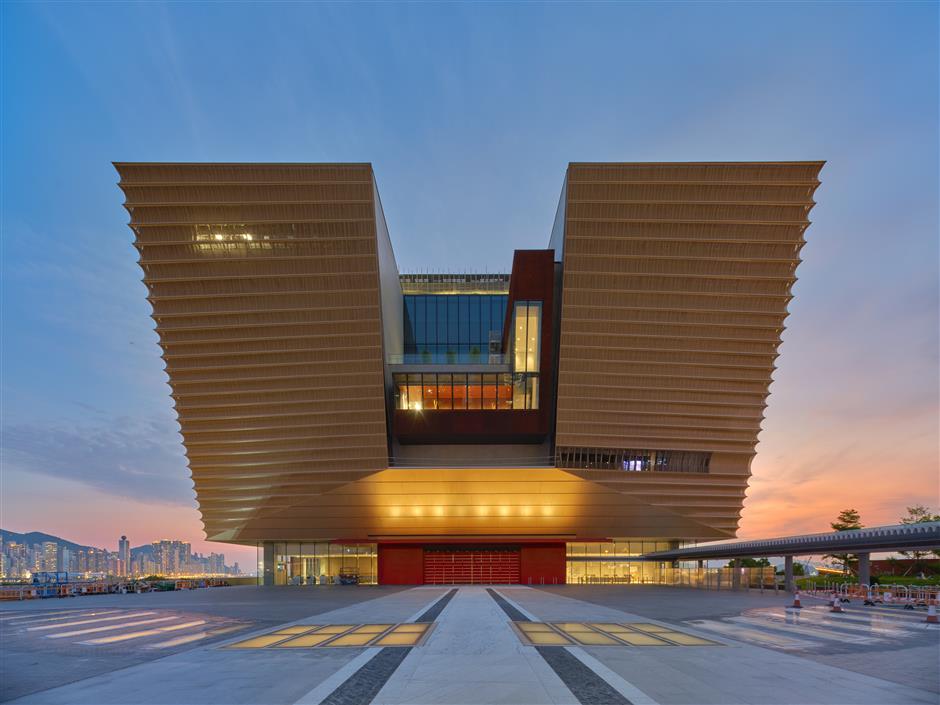Government News
Hong Kong Palace Museum director speaks on future development of the field 2024-11-06

Louis Ng, museum director of the Hong Kong Palace Museum, gives a lecture at Fudan University.
New operating concepts and modes of China's museums were discussed and explored at a lecture given by seasoned museum professional, historian, and arts administrator Louis Ng at Fudan University on Monday.
Ng, museum director of the Hong Kong Palace Museum, was invited by Fudan University's Department of Cultural Heritage and Museology to share his expertise and experience in running the iconic museum, which is now a cultural landmark in the West Kowloon Cultural District.
The museum officially opened its doors to the public on July 3, 2022. It aspires to become a leading cultural institution by embracing new curatorial approaches, offering a Hong Kong perspective with a global vision.
The museum presents the finest objects from the Palace Museum in Beijing and other important cultural institutions around the world, promoting the study and appreciation of Chinese arts and culture, and testifying to its mission — advancing dialogue among world civilizations and facilitating Hong Kong's positioning as an East-meets-West center for cultural exchange between China and the rest of the world.
Its loans from the Palace Museum are among the largest and finest the Palace Museum has ever lent to another cultural institution outside the Chinese mainland since its establishment in 1925.

Louis Ng interacted with the audience during his lecture.
More than 1,500 loan items were thoughtfully selected from over 1.86 million works in the Palace Museum's collection. Among them, 223 works, which are approximately 14 percent of the loans, are grade-one objects which are classified as "national treasures."
The treasures on loan to the HKPM are rich and diverse, covering all major categories in the Palace Museum collection from painting and calligraphy to bronze, ceramics, jade, metalwork, enamelware, lacquer, seals, costumes and textiles, jewelry, rare books, and architecture. The splendid works span nearly 5,000 years.
Ng said that in the past two years, HKPM received about 2.6 million visitors from all over the world. He and his team are dedicated to providing high-quality exhibitions and creative cultural activities for visitors.
With its architectural style and design combining traditional and modern elements, the museum is also a must-see destination for people to enjoy the poetic sunset sea views and Hong Kong's beautiful scenery.
"Museums cannot be separated from the city they are located in, and should be integrated with the local urban life," Ng said. "Education is the mission of museums. On this platform, cross-border cooperation and attempts can be innovatively made with drama, dance, and cultural products to encourage young people to participate and interact."
In Ng's eyes, innovation is the gene of Chinese civilization and the driving force behind its continuation and brilliance.
Many of the exhibitions at HKPM are curated from a creative perspective for visitors to learn about the little-known but vivid human stories and emotions behind the cultural relics.
For instance, one of the museum's thematic exhibitions is "From Dawn to Dusk: Life and Art in the Forbidden City."
Ten emperors and more than 20 empresses of the Qing Dynasty (1644-1911) had their distinct lifestyles, and their schedules varied from day to day. The exhibition allows visitors to follow in the footsteps of these former residents of the Forbidden City to experience court life from sunrise to sunset.
"Some items reflect Emperor Qianlong's filial piety and deep love for his late wife," Ng said. "With the support of multimedia approaches, we hope to present the rich and diverse history in a panoramic way and make the exhibition resonate well with the audience."

A night view shows the museum's plaza and main entrance.
With over 30 years of experience in museum planning and management, Ng also narrated the development and new trends of museums in modern times with local students, scholars, and cultural industry professionals.
In 1905, Nantong Museum, the first public museum of China, was established by patriotic entrepreneur and educator Zhang Jian in Nantong, Jiangsu province.
In the past decade, new theories, modes, and concepts have emerged in the development of museums to adapt to changing times.
Ng said that many museums have expanded their business to online platforms. Digital products, digital guided tours, and online workshops have helped to broaden and redefine today's audience base for museums.
"Digital technologies and platforms need to be specially developed for futuristic 'smart museums'," Ng said.
The remarkable development in artificial intelligence is believed to enhance interactivity and the expressive power of cultural products, and to assist in the restoration of cultural relics and artworks.
Ng added that they plan to fully digitize the collection within two years. In his opinion, he said, cultural relics are a shared asset and should be open to the public. The museum hopes to develop a dedicated AI database for its collection.
"We look forward to collaborating with Fudan University in talent cultivation and the research and application of AI technologies in the field of museums. If we make achievements, the successful mode can also be introduced to other museums."
Chinese museums have undergone tremendous development for decades. To date, there are over 6,800 museums in China, and the number of museum visitors in the country reached 1.29 billion in 2023, the highest in the world. In 2023, more than 40,000 exhibitions and over 380,000 educational activities were hosted.
The demands of Chinese residents and their enthusiasm for culture and art is ever growing. Many visitors, especially the young generation, consider visiting museums and taking short videos a new way of socializing.
Chen Zhimin, vice president of Fudan University, said the Museum of Fudan University is also under renovation, and will present multiple exhibitions in 2025 to commemorate the university's 120th anniversary.
"We will strengthen our cooperation with HKPM in many fields including exhibition exchanges, academic conference co-hosting, AI application, and international cultural dissemination," Chen said.
Source: Shanghai Daily
Application Status
| 04-16 | 21315227 | Processing |
| 03-12 | 21315226 | Processing |
| 09-26 | 21315225 | Processing |
Inquiry Status
| 02-29 | 02131558 | Received |
| 03-06 | 02131557 | Received |
| 11-14 | 02131556 | Received |
FAQ
Q: Q: Is there a place where I can get...
A: A: Log on to http://touch.shio.gov....
A: A: Log on to http://touch.shio.gov....
Q: Q: What is the easiest way to set u...
A: A: 1. Log on to http://touch.shio.g...
A: A: 1. Log on to http://touch.shio.g...
Q: Where can I get an English map of S...
A: English maps of Shanghai are availa...
A: English maps of Shanghai are availa...

